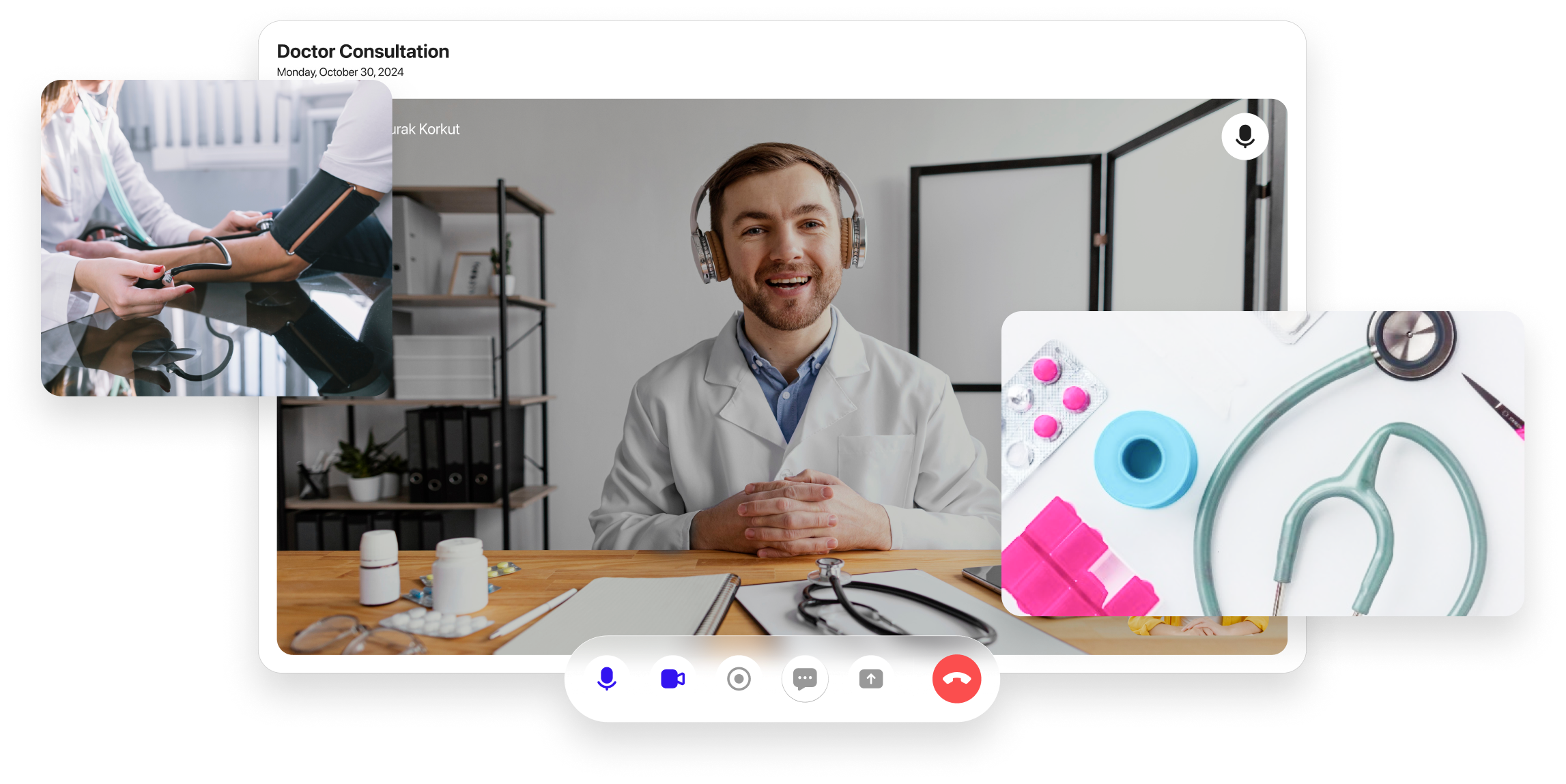150+ Hospitals Expand Patient Access With a Secure Telehealth App
See how we created a web-based telehealth app integrated with FDA-approved diagnostic peripherals, such as a camera and stethoscope, enabling healthcare providers to connect with patients and perform comprehensive remote examinations.

About Client and Key Challenges
A team of healthcare professionals came to us with a challenge. They wanted a telehealth platform that did more than just audio/video consultations.
Their current system made it hard for doctors to get real-time patient data. Diagnosis took longer because they had to rely on delayed reports. Chances of miscommunication were higher. Care coordination wasn’t smooth when patients moved between providers.
Doctors needed a way to connect peripherals and run remote diagnostic tests using the hardware they already had. They also wanted virtual consultations to be recorded for future reference, reducing risks of false claims or misdiagnosis.
Another concern was reimbursement—remote visits needed to be covered by insurance to make them financially viable.
Patients also faced issues. Many struggled to maintain continuity of care when switching providers. Access to specialists was limited, especially in remote areas.
Delayed diagnoses often led to longer recovery times.
As a medical software development company, we built a user-friendly system that made virtual care more efficient and secure.
Partnership Goal
Our client sought collaboration with a small, skilled team capable of project ownership. They needed custom healthcare software development partners with deep healthcare knowledge, a proactive approach to innovation, and expertise in cutting-edge technologies. After a consultation call with our lead developers and architect, they chose us as their ideal fit.
Our mission was to create a web based telehealth platform that is compatible with their choice of FDA approved diagnostic peripherals like stethoscope, digital cameras and printer going beyond live audio/video consultations.
Before
- Limited access to remote or underserved populations
- High infrastructure costs
- Inefficient care coordination
- Long patient travel times
- Limited specialist access
After
- Real-time consultation
- Audio/video sessions
- Diagnostics via remote peripherals
- Expanded reach to remote areas
- Lower infrastructure costs
- Enhanced patient engagement
- Improved care coordination
- Increased convenience
- Reduced wait times
- Greater access to healthcare services
- Improved health outcomes
- Virtual family participation
- Flexible scheduling options
- User-friendly interface
- Access to real-time patient data
- Compliance with HIPAA guidelines
- Secure data management and privacy protection
- Customizable and scalable solution
We selected a secure, robust tech stack for the telehealth app to meet HIPAA requirements and ensure optimal performance and patient data privacy.
Team Formation

The development of the telehealth app showcases our strong collaborative strategy. A team of eleven members worked closely with four key stakeholders from the client’s team.
We used Slack for daily updates and Asana for project management to keep communication and organization clear. As a medical software development company, we followed Agile methods with two-week sprints to keep the telehealth app development project on track. Slack was also used to handle support issues quickly.
For bug fixes, we conducted thorough testing in development, testing, and staging environments before going live. This organized and communicative approach ensured a smooth workflow and led to the successful delivery of the telehealth app.

clinics onboarded in just 12 weeks
reduction in in-person visits
increase in patient engagement
clinics onboarded in just 12 weeks
reduction in in-person visits
How We Developed a Telehealth App for Virtual Primary Care with Remote Diagnostics
We partnered with the client to create a telehealth app for remote patient care. Our solution features a secure, HIPAA-compliant system with FDA-approved diagnostic peripherals for remote examinations.
We designed the platform with an intuitive interface, making it easy for caregivers, physicians, and patients to access healthcare provider details, manage schedules, and modify appointments.
Using AWS S3, we ensure secure data storage, while Twilio enables real-time communication for smooth appointment scheduling and notifications. We also integrated Stripe and DocuSign to simplify payments and digital signatures.
Through our collaboration, we’ve developed a solution that broadens patient access, reduces costs, and enhances care delivery—combining advanced technology with a user-friendly design.

Real-time Audio/Video Consultation
The telehealth app supports real-time audio and video interactions and is used in over 95% of telehealth sessions. This feature provides a convenient and effective way for patients to connect with healthcare providers, closely mimicking in-person visits.
It enhances patient engagement, making it easy to discuss symptoms, follow care plans, and receive timely medical advice—all from the comfort of home.


Broad Device Compatibility
The telehealth platform includes portable units with FDA-compliant diagnostics, video communication, high-resolution cameras, printing capabilities, extended battery life, and real-time ECG telemetry for remote supervision.
These devices support secure and efficient medical consultations in diverse settings.


Secure and HIPAA-Compliant
The telehealth platform ensures secure patient encounters and virtual care, maintaining HIPAA compliance to protect patient data with advanced encryption and secure communication protocols.


Optimized for Remote Area
The platform is designed to perform well in remote, rural areas with limited bandwidth connections, ensuring reliable performance regardless of location.


Flexible Connectivity
Medical providers can connect from anywhere the patient is located, while providers can conduct encounters from their office or home, enhancing the speed and efficiency of e-visits.

What happened next - Results
Working closely with our client, we developed a user-friendly platform that simplifies virtual care through telehealth app development. The app's intuitive design and seamless workflow make it easy to schedule appointments and conduct fully remote patient examinations anywhere, anytime.
This includes robust, real-time audio and video consultations that mirror in-person visits and significantly enhance patient-provider interactions. These features translate into tangible benefits: improved communication, reduced ER visits, shorter hospital stays, and better health outcomes.
The dual commitment to HIPAA compliance and FDA-approved technology underscores the app's dedication to providing a secure and trustworthy environment for delivering high-quality virtual primary care services. The app's success story is evident: within 12 weeks of launch, over 50 clinics and numerous hospitals adopted it, positioning it as a leader in the healthcare industry.
The client was delighted with our approach, commending our efficient management and precise fulfillment of their needs at every step. Looking ahead, we're collaborating on the next version, packed with innovative features to further empower patients and healthcare providers. This custom healthcare software development process will continue to evolve, ensuring the platform remains a top choice for virtual primary care.






